Quick search
CTRL+K
Quick search
CTRL+K

Brussels is home to the European Parliament, for many, one of the symbols of the European Union, but the Belgian capital has so much else to offer from its long Flemish history. The city center is Grote Markt / Grand Place, which is considered one of the most beautiful squares in the world.
Only a few minutes walk from Grote Markt, you can see the figure Manneken Pis, the boy who continues to pee after many centuries. And in the old town center there are numerous sights in an easy walking distance from one place to another. Manneken Pis is by the way seen seasonally with different clothes and he always draws many tourists.
Buildings from later centuries are also worth going for. The impressive National Basilica, the magnificent Jubilee Park and the landmark Atomium are among the places that attract loads of visitors. Jubilee Park is an impressive park complex with large buildings that symbolize Belgium’s achievements.
There are also many tasty choices of gastronomy to make on a trip to Brussels. Belgian chocolate is famous and there is no greater variety than in Brussels, where the Belgian beer is never far away either. And when you want to make a day trip, several things unfold in the vicinity of the city; eg Waterloo and other Flemish cities such as Leuven, Antwerp and Ghent.
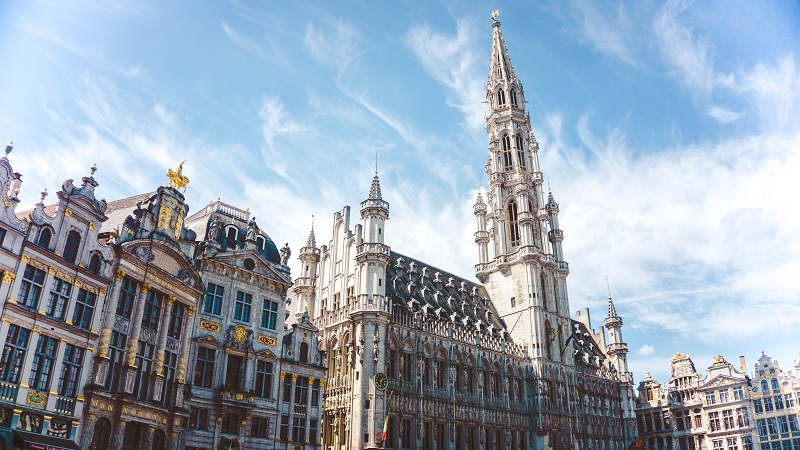
Grand Place, also known as the Grote Markt, is one of Europe’s most beautiful squares from its time, and here you can enjoy the region’s Flemish Renaissance architecture at its best. It is therefore no surprise that the square has been on UNESCO’s list of world heritage sites since 1998.
It is an incomparable and unforgettable sight when you enter the Grand Place and see the town hall, the beautiful houses and the impressive artistic touch with gold and ornamentation that the individual buildings have. You should enjoy the square’s overall impression and atmosphere, and you can also take a closer look at the many individual sights.
The construction of the Grand Place began in the 11th century, and buildings were built around the square over the centuries. During the War of the Palatinate Succession, most of the square was laid in ruins in 1695 as a result of French bombardments. Therefore, the current buildings mainly originate from the reconstruction in the period after that.
The square’s French name, Grand Place, refers to the fact that the square was traditionally the largest square in Brussels. Grand Place is called Grote Markt in Flemish, and from that you can deduce that it was also here that the city’s largest market was located in its time. Today there is no longer a market on the Grote Markt, which is however one of Brussels’ most famous landmarks.
Among the many buildings around the square is Brussels’ beautiful town hall, the King’s House/Brødhuset and a number of buildings that the city’s leading trade and craft guild built in its time. The Town Hall from the 15th century was the city’s major civil building, and to match it, the Duke of Brabant built the King’s House in the 16th century.
Manneken Pis is a world famous bronze statue of a little boy urinating in a basin. The 61 centimeter tall Manneken Pis was produced in 1618 or 1619 by Jérôme Duquesnoy l’Ancien and was erected in 1619 as a source of drinking water for the townspeople. The peeing boy quickly became more and more popular, and it is today one of the landmarks of Brussels.
There are different stories about the background of the setting up of the statue. One story goes that a boy had gone missing and that the boy’s father wanted to erect a statue for him showing the situation he found him in. The boy was found urinating and thus the statue of Manneken Pis was created. However, this probably already happened in the middle of the 15th century, when Manneken Pis is mentioned for the first time.
The original bronze statue from the 17th century was replaced with a copy in 1965, and it is the one that can be seen urinating in the streets of the Belgian capital today. During the replacement, the original was moved to Brussels’ city museum on the Grand Place, where it can still be seen in the museum’s exhibitions.
The small statue is a very popular target for tourists, and it has become a tradition for foreign heads of state to bring their country’s national dress to Manneken Pis. On a visit to the statue, you can also see Manneken Pis wearing different suits, and the boy’s eventually countless wardrobes can be seen at the Garderobe Mannekenpis museum, which is also located in Brussels.
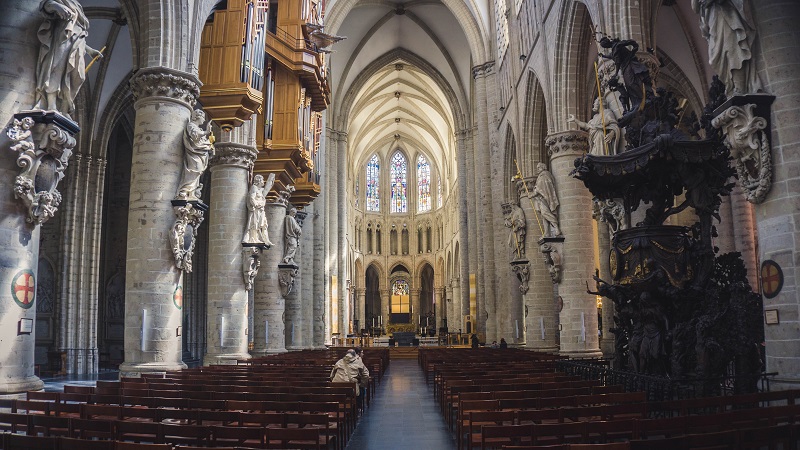
Saint Michael and Gudula Cathedral is the Roman Catholic cathedral in Brussels. Its name comes from the cathedral’s dedication to Saint Michael and Saint Gudula, the patron saints of Brussels, and that history dates back to the church’s early history.
The great cathedral is considered one of the finest buildings built in the so-called Brabant Gothic. This form of Gothic was a variant in the Netherlands, which arose with the construction of Sint-Romboutskathedraal in the city of Mechelen; it was consecrated in 1312.
It is believed that as early as the 8th century a church dedicated to Saint Michael was built on the site where Brussels’ cathedral stands today. Back then, it was the place where the two main trade routes crossed. In the 11th century, a new church was built several times, and the relics of Saint Gudula were brought here.
Construction of the current cathedral started in 1226 and initially lasted until 1276, when the church room itself was completed. In the middle of the 15th century, the impressive facade was completed, while the entire cathedral was completed in 1519 after almost 300 years of construction. However, the cathedral was rebuilt after the inauguration with, among other things, several chapels throughout the 16th and 17th centuries.
The large church building was granted cathedral status in 1962 and has been beautifully restored in recent years. Today you can enjoy the beautiful Brabant Gothic, which is the primary architectural style, but there are also later changes from the Baroque.
The facade with the two towers of 64 meters in height is inspired by French Gothic, but unlike Gothic cathedrals in France, Saint Michael and Gudula Cathedral does not have a rose window, but a pointed arched window in typical Brabant Gothic.
Inside, you can e.g. see many glass mosaics, Hendrik Frans Verbruggen’s pulpit from 1699 and interesting late Gothic chapels from the 16th-17th centuries. You can also see fine statues of Jesus’ disciples, which are mounted on the large pillars through the church space. The statues date from the 17th century and were produced by leading contemporary artists.
The Basilique nationale du Sacré-Coeur is a colossal basilica located a few kilometers from the center of Brussels. It was King Leopold II who wanted to have the National Basilica of the Sacred Heart built for the ever-growing population of the city.
Construction of the great church began in 1905, when Leopold II laid the foundation stone on the occasion of the 75th anniversary of Belgium’s independence. Due to the two world wars of the 20th century, construction came to a standstill several times, and the church was only completed in 1969, although it was officially consecrated in 1935.
The history of the basilica goes back to King Leopold I, who in the mid-1800s wanted to turn the Koekelberg hill into a royal residence area. King Leopold II first wanted to build a national cemetery with a Parisian model, but the plans were changed to the current basilica after the king’s visit to the Basilique du Sacré-Coeur in Paris in 1902.
Initially, the construction was intended as a large neo-Gothic basilica, but after the First World War the design was changed to the art deco of the time, and upon completion in 1969, the national basilica was the world’s largest construction in art deco.
The Basilique nationale du Sacré-Coeur has impressive dimensions with a height of 89 meters and an external length and width of 164.5 meters and 107 meters respectively. The church’s dome has a diameter of 33 meters and can be seen from large parts of Brussels. Inside you can see a large church room with many of the Art Deco design details.
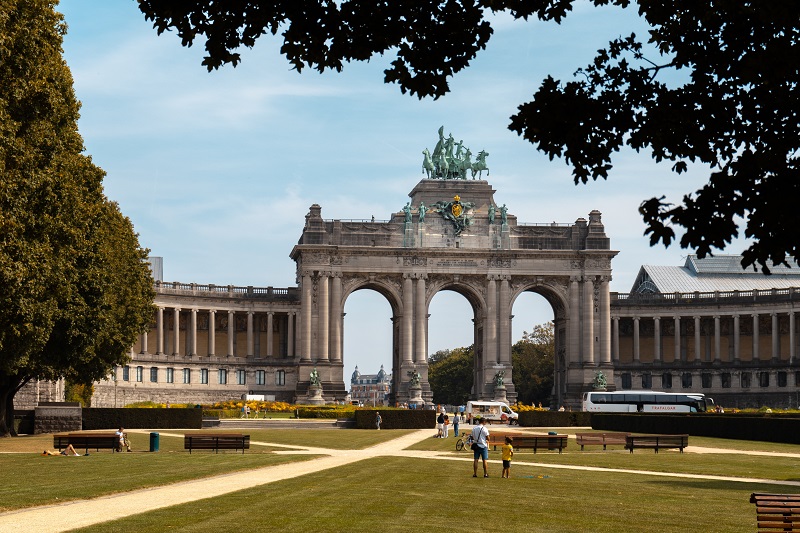
Jubelpark, called Parc du Cinquantenaire in French, is an impressive park and building complex that was built for the World Exhibition in Brussels in 1880. In the center of the park is a large and majestic triumphal arch with the connected wings forming a large horseshoe shape around the esplanade, which is a favorite park among the city’s citizens. Before construction, the large area was used for military exercises, and it was then outside the city.
The Arc de Triomphe in the center of the complex was supposed to be a symbol of the 50th anniversary of the founding of the Belgian state, but it was actually only ready for the 75th anniversary in 1905 in its current version, having been temporarily built partly in wood to have an arch for the exhibition in 1880. It was to take an extra 25 years before private funding could complete the monument.
It was architect Charles Girault who completed the arch, which he redesigned, just as he also changed much of Gédéon Bordiau’s architecture from the 1880s. Girault’s central arch is topped by a four bucket symbolizing the raising of the Brabant flag. On the arch there are also figures symbolizing the Belgian provinces.
In Jubelpark you can enjoy the green surroundings, and there are also quite a few good museums in the old exhibition halls. It concerns the Autoworld car museum, which has one of the world’s largest collections, a military history museum (Musée royal de l’Armée et d’Histoire militaire/Koninklijk Museum van het Leger en de Krijgsgeschiedenis) and the city’s museum of art and history; Musées royaux d’Art et d’Histoire/Koninklijke Musea voor Kunst en Geschiedenis.
Atomium is one of the landmarks of Brussels, and it is known from countless photographs of the iconic building. The Atomium was built for the World Exhibition in Brussels in 1958 and is shaped like a large molecule. The world exhibition Expo’58 took place in Laeken in the northern part of the Belgian capital.
The Atomium was designed by engineer André Waterkeyn and architects André and Jean Polak. The work is 102 meters high, and each of the nine spheres in the atom is 18 meters in diameter. You can enter the distinctive building, where you move from sphere to sphere through the connecting pipes, each of which has a diameter of 3 metres.
When you enter the Atomium, you will experience an exciting and different construction, and in addition to the tour itself, you can see changing exhibitions inside the individual spheres of the atom. In the upper sphere there is a restaurant and a nice view of Brussels.
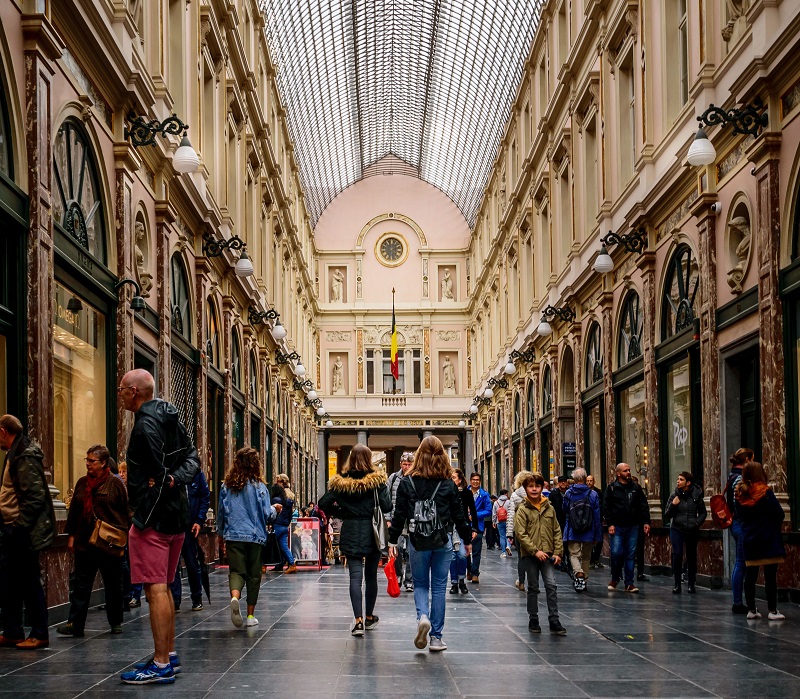
Built on the initiative of King Leopold I in 1846-1847, this fine gallery building was Europe’s first truly modern shopping center. The galleries consist of several parts with two main buildings in extension of each other and a side street. From the south, it is respectively the Queen’s Gallery/Koninginnegalerij/Galerie de la Reine, the King’s Gallery/Koningsgalerij/Galerie du Roi and the side street Prince’s Gallery/Prinsengalerij/Galerie des Princes.
The building is very elegant with the long arcades and the vaulted glass superstructure. The style is renaissance. Today, the galleries are still furnished with shops, eateries and more, and they have provided inspiration for several other shopping centers around the world.
The city hall is the central and dominant building of the Grand Place, which was built in the period 1402-1459 as the most prestigious official building in the country. The eastern wing is the oldest and dates from 1402-1420, while the slightly smaller western wing was built in a few years after 1444. As the last of the complex, the 96 meter high tower was completed in 1455. The tower was designed by Jan van Ruysbroek , and the top is adorned by Michaël/Michel, who is the city’s patron saint.
The building is a lavish example of the Brabant Gothic style, whose name comes from the region of Brabant. Inside, the fantastic rooms can be seen on tours, where the town council hall and alderman’s hall in particular impress with their decoration and tapestries from the 15th century.
On the facade you can see countless statues representing the local nobility, saints and allegorical figures. You can thus see dukes and duchesses of Brabant and knights from noble families. The current statues are copies from the 1800s and 1900s, and you can see the originals from the 15th century at the city museum, located in Kongens Hus opposite the town hall building.
The town hall burned down after a French bombardment in 1695, which happened during the War of the Palatinate Succession. After the destruction, only the facade and the town hall tower remained, and in the following decades the beautiful building was rebuilt and in some places also expanded into the complex that stands today.
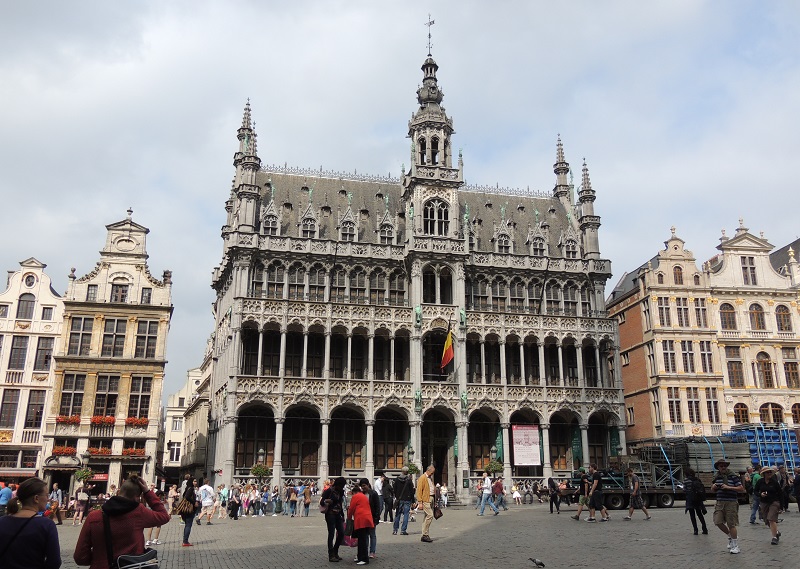
Opposite Brussels’ town hall is the King’s House, which was built in the years 1504-1536. The beautiful house was built as an administration building by and for the dukes of Brabant, and it was a counterpart to the city of Brussels’ impressive town hall building from the 15th century.
The King’s House is called Maison du Roi in French, while it is called Broodhuis in Flemish. This name comes from a wooden house from the 12th century, which housed a bread sale. Even after the demolition and construction of the Maison du Roi, the name Broodhuis continued after the historic bakery on the site.
In the beginning, however, the King’s House was called the Duke’s House, because the ruling nobility were Dukes of Brabant. The name changed when one of the Dukes of Brabant became King of Spain; this was, of course, before the Belgian Revolution and thereby the establishment of the State of Belgium and the Belgian Monarchy.
After the original construction in the 16th century, Kongens Hus has been rebuilt several times. The first time was after the French bombardment during the War of the Palatinate Succession in 1695, when most of the Grand Place was left in ruins. In 1767, the building was partially changed during neoclassicism, while the current neo-Gothic King’s House is the result of a rebuild between 1874 and 1896, where the architect Victor Jamaer, among other things, erected the central tower.
Since 1887, Brussels’ city museum, Museum van de Stad/Musée de la Ville, has been located in the King’s House. You can see exciting exhibitions from highlights of the city’s history. Here are i.a. see exhibited paintings, tapestries and various descriptions and objects from the city’s history. It is also here that you can see the original 15th-century statues from the town hall facade opposite the Royal Palace.
Brussels City Museum has been located here in the beautiful building the King’s House since 1887, and here you can experience many exciting exhibitions from highlights of the Belgian capital’s history. You get, for example, a good impression of early Brussels and the city in rapid development in the 16th century through two dioramas.
You can also see a number of paintings by Flemish and French artists such as Aert van den Bossche and Charles Meynier. The two artists worked in the 15th and 18th centuries respectively.
The museum also offers interesting effects, and this is where you can see the original 15th-century statues from the town hall facade opposite Kongens Hus. These are statues that adorned the facade with dukes and duchesses of Brabant, saints and allegorical figures, and today there are copies of the statues on the town hall facade.
At the Brussels City Museum you can also see the original Manneken Pis statue. Manneken Pis is a bronze statue that was created by Jérôme Duquesnoy l’Ancien in 1618 or 1619. The original status peed in the streets of Brussels until 1965, when a replica was erected, on which occasion the original entered the city’s municipal museum.
The city museum is housed in Kongens Hus, which was built in the years 1504-1536. The beautiful house was built as an administration building by and for the dukes of Brabant, and it was a counterpart to the city of Brussels’ impressive town hall building from the 15th century.
The church is one of the oldest in Brussels. It is known to be mentioned for the first time around the year 1200, when the church was a chapel that was located by the city walls. The current church was built from 1854, but the tower from 1629 was retained from the site’s former church. Inside you will find a sculpture from the 14th century of the Black Madonna.
The square in front of the church is one of the city’s markets; it used to be the city’s largest fish market, and here you still eat good fish and seafood dishes. Both the fish and the relatively late construction period are due to the fact that the city’s historic harbor stretched here through several basins. The actual site where the church stands today was Sint-Katelijnedok/Bassin du Sainte-Catherine.
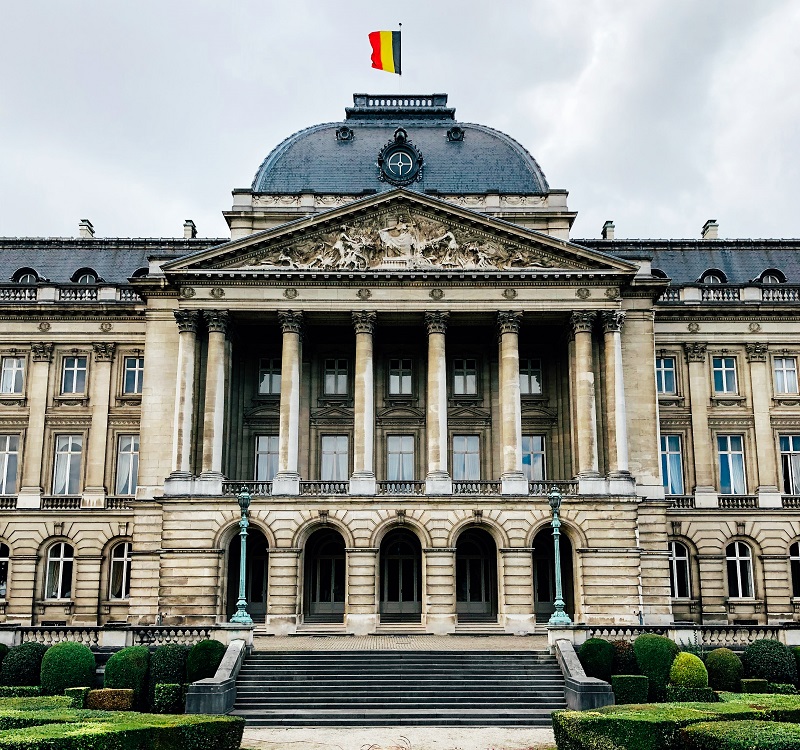
The large royal palace, Koninklijk Paleis/Palais Royal, was originally built in the latter half of the 18th century, but the current facade dates from the 20th century. However, there has been construction on the site since the 11th century, which was continuously built by the Dukes of Brabant.
It was, for example, in a former palace that the well-known throne room Magna Aula was built in the 15th century for Philip III. The old complex burned down in 1731, and with the urban renewal of the area in the 1770s, the last remains of the now defunct palace were demolished.
The palace is today the official residence of the Belgian royal family. There are many interesting and impressively decorated halls in the palace; eg King Leopold II’s throne room, the Congo-inspired hall of mirrors, and the Goya room, where there are Spanish tapestries woven according to Goya’s drawings.
The Congress Column is a column that was erected in the 1850s to commemorate the formation of the Belgian state by the National Congress in 1830. The column was inspired by Trajan’s Column in Rome, and the top of the 47 meter high monument is a statue of King Leopold I.
On the pedestal, you can see significant dates and events with significance for the formation of the Belgian state. The statues here represent the basic freedoms of the country.
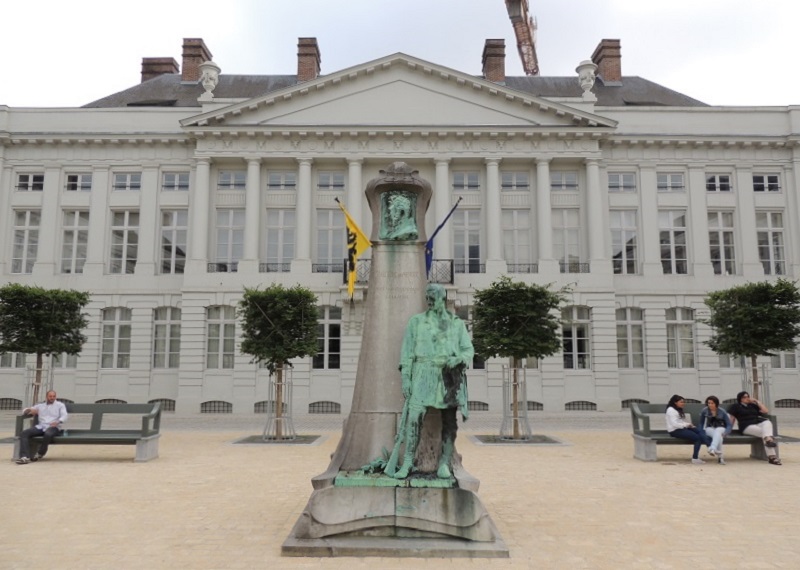
The Martyrs Square is an elegant square in the central city and it is one of the most beautiful in Brussels. When you enter the square, the yellow stones seem almost like sunshine and stand in fine contrast to the surrounding bright houses.
The Martyr Square is named after those who fell in the Belgian independence battles in September 1830. The battles led to the country’s independence.
The buildings around the square form a homogeneous row of neoclassical houses that were built according to Claude Fisco’s drawings in the years 1774-1778. In the middle of the square stands a fatherland monument, and the house at the northern end is the office of the Flemish head of government.
The Onze-Lieve-Vrouw ten Zavel church is considered one of Belgium’s most beautiful. It was built in the Gothic style in the period 1400-1550. There are many beautiful details in the church’s decoration and interior, and the fantastic window mosaics are particularly well known.
The mosaics can be seen all around the church room. There are, for example, 11 windows each 14 meters high in the choir. Other details are Gothic elements and the distinguished chapel next to the choir.
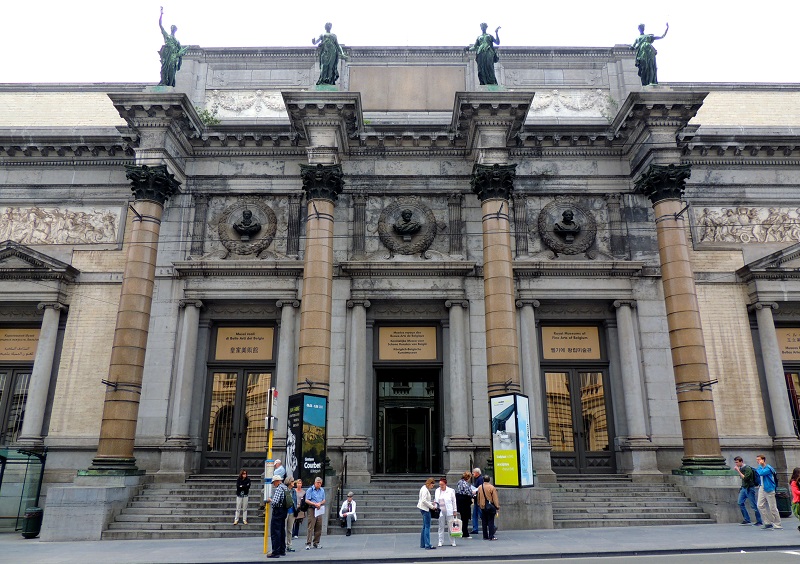
This is Belgium’s largest museum with fine collections of older (1400-1700) and modern art (1800-). The museum building itself was built in neoclassical style in the period 1874-1880. However, the museum was originally founded by Napoleon in 1801, and it was located elsewhere at first.
The museum’s older section is known for its fine collection of Flemish art. You can see works by, among others, the masters van Dyck and Rubens. The department of modern art was established in 1984. The collection is very broad, and among the highlights is the world’s largest collection of René Magritte’s artworks.
Brussels is the main city for the administration of the European Union, and various EU institutions are located in the area. The Berlaymont building is perhaps the closest the EU has come to an actual landmark for supranational cooperation. The building, which was built in a 55 meter high, four-pointed star shape, houses the European Commission. The Council of Ministers also has its administration here.
A nunnery was located on the site until the 1960s, which moved to Waterloo with the plans for the Berlaymont building. Berlaymont was built in the years 1963-1969, and the building was used until 1991, when a renovation was started. In 2004, EU bodies could move in again.
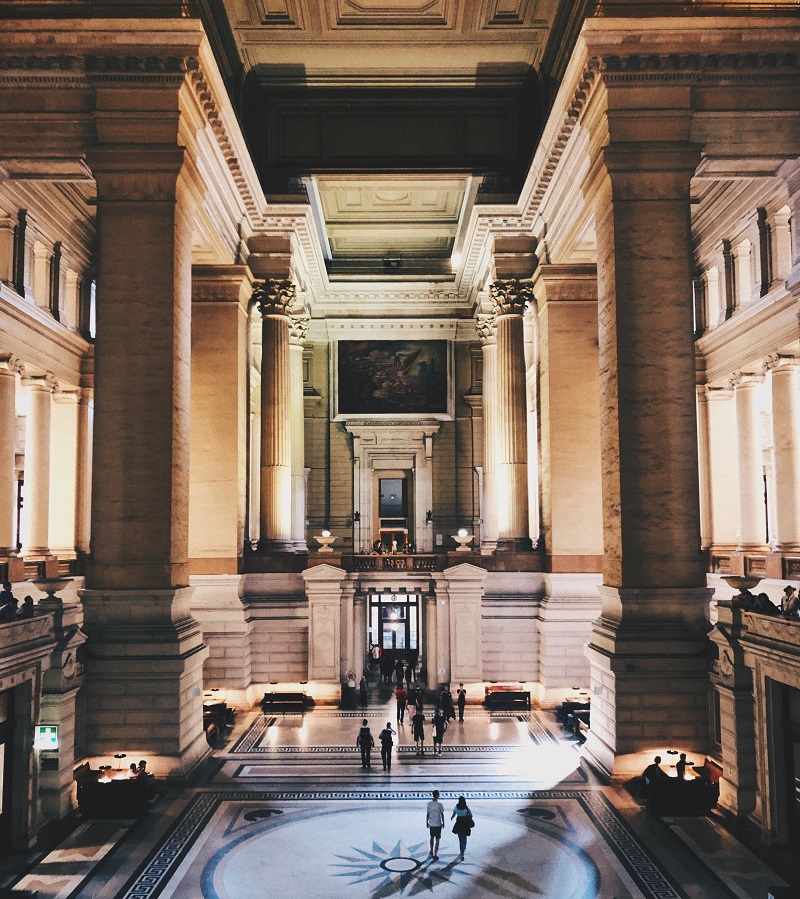
The Palace of Justice, which houses Brussels’ courts, is large and impressive like a castle. The building was constructed in 1866-1883 according to King Leopold II’s ideas for a new Brussels, and the dimensions are impressive. The ground plane is 160×150 meters, and there are 105 meters to the dome.
The place where the Palace of Justice was built was the city’s former gallows hill. It rises 20 meters above the surrounding street level, and death row prisoners were hanged here in the past. With its high location, there is a fine view of the city from the promenade in the square in front of the building. Here you can also see a monument commemorating those who fell during the Second World War.
Victor Horta’s art nouveau monuments can be found in many places in Brussels. He was also the architect who influenced the city most during his time in the decades around 1900. The house here was built 1898-1901 by Victor Horta, who not only designed the house, but also the design of most details in the interior.
The house and the museum are an experience in the art nouveau style in Horta’s own way, where, among other things, the choice of materials and design is interesting. Pay particular attention to the staircase and the furnishings of the rooms such as the dining room.
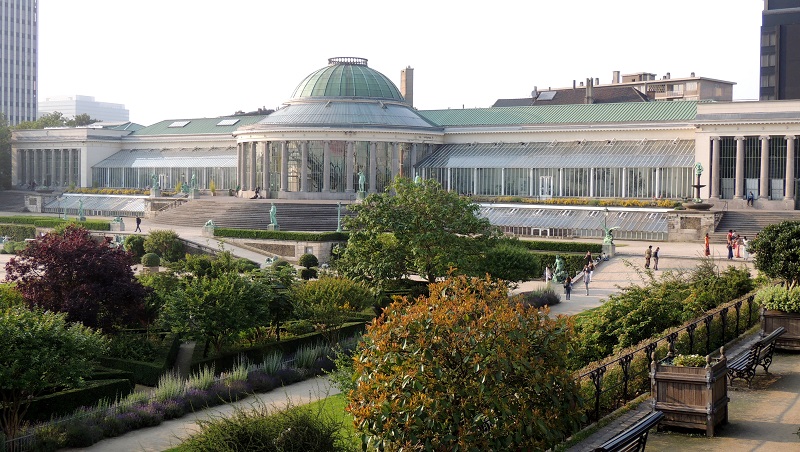
When France annexed Belgium at the end of the 18th century, one of the cultural results was the establishment of the city’s botanical garden. It was established in 1796 in the park from the now historic castle Koudenberg/Coudenberg.
The garden closed again in 1826, but parts of the fine structure were retained. Thus, today you can see several sculptures and installations from the 19th century. Here is also the large, beautiful greenhouse, which is the site’s landmark, and which today is set up as a French-language cultural centre. Various exhibitions are regularly held here.
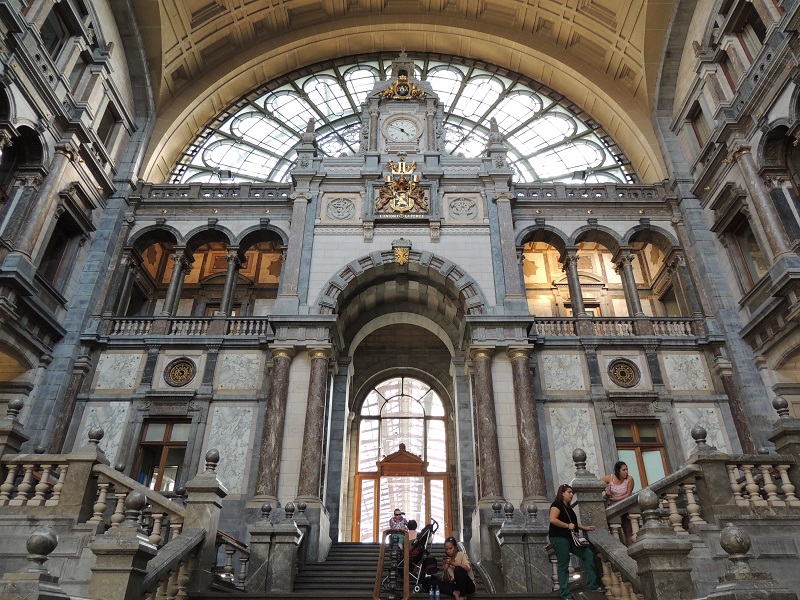
Antwerp is a Flemish metropolis that has become rich after centuries of large-scale trade with the whole world, and it can still be seen today with the city’s activity and busy port. With Antwerp’s strategically good location, it has developed into one of Europe’s largest port citys.
The city center is beautiful and characterized by the wealth that through time made the city’s commercial and religious buildings possible to build. Many areas have richly furnished houses with Grote Markt as the central square. When in town, it is just about exploring central Antwerp and enjoy the fine architecture and atmosphere here.
Belgium’s time as a colonial power can be experienced here at the Royal Museum for Central Africa. The focus is on the Belgian Congo, which was the country’s colony until 1960, when the central African country gained independence.
The museum was opened in 1899, and the collections have been continuously expanded since then, so that today it covers Belgium’s colonial history in a distinguished way. There are also collections of objects and animals from Africa, and thus the museum also gives an insight into life in the colony.

Leuven is one of the well-known Flemish cultural cities in Belgium. The city is known to be mentioned for the first time in 891 in connection with the Battle of Leuven. Over the following centuries, the city developed into one of the most important trading cities in the Duchy of Brabrant, which was a state in the Holy Roman Empire.
There was also a large textile production in the 1400s and 1500s, and the 15th century became a golden age for the city with the foundation of the university in 1425 and the construction of large buildings such as Leuven’s town hall. The city continued as a center of knowledge, and Erasmus and Gemma Frisius worked here. Throughout the 1700s and 1800s, Leuven was rapidly developed, and the industry developed with Den Horn brewery and others.
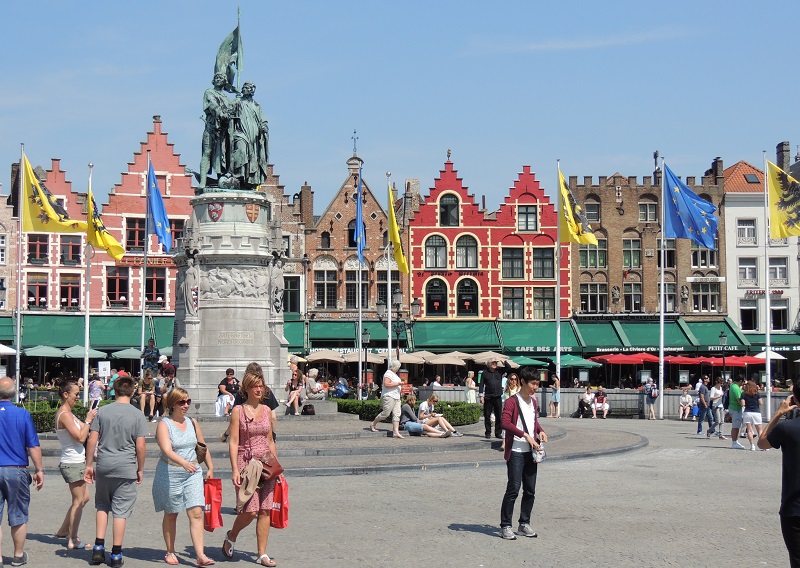
Bruges is one of Europe’s old and rich trading centers, where the fine history of merchants and shipping has created a tourist gem in western Flanders. Here, Flemish urbanization has, over time, gone hand in hand with cultural and economic progress, and the result is so picturesque and interesting with loads of beautiful buildings.
The city’s central squares with Markt and Burg at the forefront are great places to enjoy the the spirit of centuries of architecture. Churches are located at the squares, where the town hall and other famous buildings have been built on the profits of the trade.
The battle of the city of Waterloo on 18 June 1815 is historically world famous. It was here that Napoleon met armies from England, Germany and the Netherlands under the leadership of the Duke of Wellington.
The great battles unfolded over just a single day, during which the French troops were put to flight. It was the defeat that led to Napoleon’s downfall. The French leader abdicated and lived the rest of his life on the Atlantic island of Saint Helena.
Today you cannot see the setting of the great battle in the landscape, but instead you get a good overview in the Musée Wellington Museum and other places with a historical connection to the event.
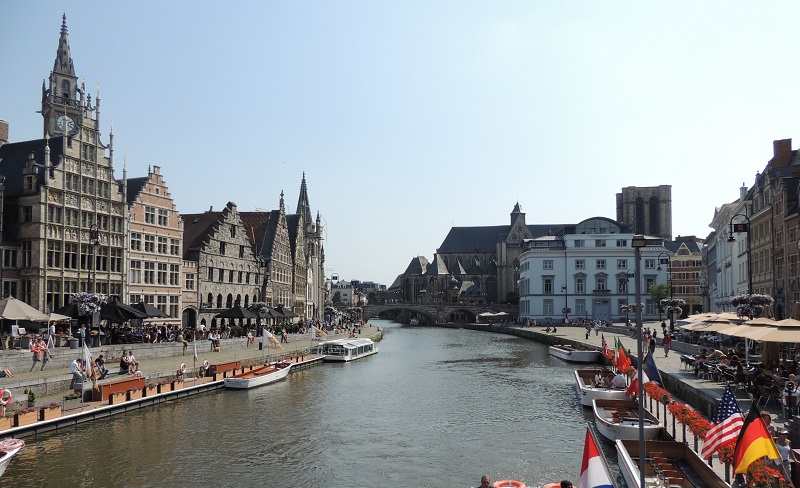
Ghent is a city with a past as one of Europe’s largest cities. It was once the center of Europe’s wool and textile trade, and there was a strong urbanization and industrialization early on. Together with the success of the merchants, it created tremendous wealth, which resulted in, for example, many of the beautiful buildings visitors can see in the city center today.
Cathedrals, churches, monasteries, squares, merchant residences and museums are located in large numbers between the canals in the old town which have retained its medieval character. The large buildings stands next to each other, and the city center is laid out nicely as a continuous open urban space.
Anspachlaan 24/Boulevard Anspach 24
Keizer Karellaan 420/Avenue Charles Quint 420
basillix.be
Nieuwstraat 123/Rue Neuve 123
Nieuwstraat 111/Rue Neuve 111
inno.be
Beenhouwersstraat/Rue de Bouchers
Boulevard Sylvain Dupuis 433
westlandshopping.be
Woluwedal/Boulevard de la Woluwe
woluweshoppingcenter.be
Around Grote Markt/Grand Place, Beenhouwersstraat/Rue de Bouchers, Nieuwstraat/Rue Neuve, Zuidlaan/Boulevard du Midi, Waterloo Avenue/Boulevard de Waterloo, Louizalaan/Avenue Louise
Autoworld
Jubelpark/Parc du Cinquantenaire
autoworld.be
Bruparck
Eeuwfeestlaan/Boulevard du Centenaire
bruparck.com
Mini-Europe
Bruparck
minieurope.com
Museum voor Natuurwetenschappen/Muséum des sciences naturelles
Vautierstraat 29/Rue Vautier 29
sciencesnaturelles.be
Oceade
Bruparck
oceade.be
Museum for het Stedelijk Vervoer/Musée du Transport Urbain
Tervuerenlaan 364/Avenue de Tervueren 364
mtub.be
The priest Saint Gorik built a chapel on an island in the river Zenne around 580. The island was centrally located in present-day Brussels until the 19th century, when Zenne was covered. The island was called Saint Gorik Island / Sint-Gorik Island / île Saint-Géry, and Gorik’s chapel marked the start of those who would later grow into an actual settlement and city.
Saint Gorik’s chapel was located in the marshlands along the river, and the name Brussels is also believed to come from the old Dutch broeksel, which means the home of the marsh. Incidentally, the symbol of the Brussels region is an iris that was a typical flower in the surrounding area.
Although a chapel had already been erected, Brussels was first founded in 979, when Karl of Lorraine brought the relics of Saint Gudula from the city of Moorsel in Flanders to Saint Gorik’s chapel. On that occasion Karl made the first fortifications, and they brought about an actual settlement.
Around 1000, Lambert I, Count of Leuven, gained control of Brussels, marrying Karl of Lorraine’s daughter. In the mid-1000s, the city’s defense works were expanded by Lambert II Baldric, who also erected the first of the city’s expanded defense works.
Brussels was centrally located with its location on the river Zenne and on the trade route between the cities of Bruges and Ghent in the west and Cologne in the east.
Trade flourished, and with Brussels’ natural location on the trade routes, many settled permanently in the city, which quickly spread from Saint Gorik Island to the districts that now form the city center. Among other things, these neighborhoods had the advantage of being protected from the floods that hit the flood-prone houses.
Throughout the Middle Ages, present-day Flanders was one of Europe’s most urbanized areas with almost unstoppable economic, cultural and population growth, and this also applied to Brussels.
In the 13th century, the city got its first city walls. They were raised by the rulers of Leuven, who had now become the duke. The walls created increased security, which in turn was the breeding ground for the influx of new migrants. There were so many people moving to the city that already 1356-1383 new and expanded city walls had to be built.
Many lows were formed during these centuries and businesses were established. The nobility also rebuilt the area with castles and defense works, so there was a time of great growth. Politically, Brussels’ first constitution was published in 1229 under Henri I, one of Brabant’s dukes.
The former rulers were from Brabant, but it was not to continue. Thus, in 1384-1477, Burgundy was in power in Brussels. The Burgundians were known for their gastronomy, and it can still be tasted in Belgian cuisine.
Through royal marriage, Brussels became part of the kingdom of the Habsburgs. The Habsburg emperors continued to expand the city; including large duct systems that provided further growth.
In 1516, Karl V was proclaimed Spanish King in Brussels’ Saint Michael and Gudula Cathedral / Sint-Michiels-en-Sint-Goedelekathedraal / Cathédrale des Saints-Michel et Gudule. Karl had been heir to the Netherlands since 1509, and in 1519 he was crowned German-Roman emperor after the death of grandfather Maximilian Is.
In 1555, the Habsburgs surrendered to Charles V power over Brussels and left the country to Spain and King Felipe II. Resistance to the king of distant Madrid increased. Holland’s William of Orange assisted the Belgians, and the Spanish leader, the Duke of Alva, had to flee, however, to return eight years later.
During this time, Spain gradually became weaker, and in 1695 the French sun king Louis XIV attacked Brussels. More than 4,000 houses were damaged on that occasion and the Grote Markt/Grand Place was almost completely destroyed.
The Spaniards retained dominion until the Utrecht Agreement in 1713, ending the Spanish War of Succession. The Spanish Netherlands, including Belgium, were handed over to the Habsburgs in Austria.
In the same century, a new succession war broke out. This time it took place in Austria, and during the conquest of France Brussels in 1746. However, the French presence lasted only three years.
It was a tight deadline, for although the Austrians sought to strengthen the development of Brussels, the Austrians were weaker, and in France a revolution had brought new leaders and they sought expansion.
French troops invaded the city in 1794, and the following year they declared the area French. New departments were created and Brussels became the capital of the Dyle region. Brussels remained French until 1815, when Napoleon’s time in power had ceased.
After Napoleon’s fall in 1815 at Waterloo outside Brussels, the United Netherlands was established by Belgium, the Netherlands and Luxembourg.
Already in 1830-1831 Belgium became independent after a freedom struggle against the Dutch leaders. Leopold I was declared the country’s first king in 1831, and Brussels became the capital.
A large-scale construction of the new Belgium started. The old city walls were demolished and huge buildings were erected. At the same time, there was great enthusiasm in the city that wanted to hold international exhibitions, found scientific institutes and other things that could secure the country a place in Europe and the world. For example, it brought cultural figures such as Victor Hugo and Karl Marx to the city.
The latter half of the 19th century was also Belgium’s heyday as a colonial power with the royal power and Brussels at its center. The colonies spoke 70 times the area of Belgium.
Belgium did not participate in the Franco-German War of 1870-1871, but the war contributed to rising nationalism in the Flemish and French parts of the country; a relationship that still characterizes the country and the common capital of Brussels.
Around the same time, the flow and pollution of the river Zennes through central Brussels had become too high a risk to public health, and the river was completely covered. On that occasion, Saint Gorik Island disappeared, but in turn new and wide boulevards could be brought.
Brussels, at the beginning of the 20th century, remained a mainly Dutch-speaking city. The language, culture and history had mainly come from other cities in Flanders, but it was formally changed in 1921, when the city and country were divided into zones. To the north lay the Dutch-speaking Flanders, to the south the French-speaking Wallonia, while Brussels as its capital officially became bilingual.
The two world wars in the 20th century did not significantly slow down the city’s development. Construction continued and international relations were constantly sought to be developed.
Among the successes were the very large exhibitions, and Brussels came twice to host world exhibitions. It happened in 1935 and again in 1958. The fifth Solvay Conference in Physics and Chemistry was also held here; it was in 1927.
In the 1950s, Belgium joined the Coal and Steel Union, a precursor to today’s European Union, which has greatly influenced the knowledge of Brussels internationally. The city is the main city for parts of the EU administration. The Commission, the Council of Ministers and one of Parliament’s buildings were put into place when the institutions were to be established, and in addition the NATO defense alliance was given administrative headquarters in the city.
The development of recent decades has primarily taken its pivotal role in the continued expansion of cooperation in the EU and the trade, economy and tourism it entails.
 Brussels, Belgium[/caption]
Brussels, Belgium[/caption]
Overview of Brussels
Brussels is home to the European Parliament, for many, one of the symbols of the European Union, but the Belgian capital has so much else to offer from its long Flemish history. The city center is Grote Markt / Grand Place, which is considered one of the most beautiful squares in the world.
Only a few minutes walk from Grote Markt, you can see the figure Manneken Pis, the boy who continues to pee after many centuries. And in the old town center there are numerous sights in an easy walking distance from one place to another. Manneken Pis is by the way seen seasonally with different clothes and he always draws many tourists.
Buildings from later centuries are also worth going for. The impressive National Basilica, the magnificent Jubilee Park and the landmark Atomium are among the places that attract loads of visitors. Jubilee Park is an impressive park complex with large buildings that symbolize Belgium’s achievements.
About the Whitehorse travel guide
Contents: Tours in the city + tours in the surrounding area
Published: Released soon
Author: Stig Albeck
Publisher: Vamados.com
Language: English
About the travel guide
The Whitehorse travel guide gives you an overview of the sights and activities of the Canadian city. Read about top sights and other sights, and get a tour guide with tour suggestions and detailed descriptions of all the city’s most important churches, monuments, mansions, museums, etc.
Whitehorse is waiting for you, and at vamados.com you can also find cheap flights and great deals on hotels for your trip. You just select your travel dates and then you get flight and accommodation suggestions in and around the city.
Read more about Whitehorse and Canada
Canada Travel Guide: https://vamados.com/canada
City tourism: https://visitwhite-horse.ca
Main Page: https://www.vamados.com/
Buy the travel guide
Click the “Add to Cart” button to purchase the travel guide. After that you will come to the payment, where you enter the purchase and payment information. Upon payment of the travel guide, you will immediately receive a receipt with a link to download your purchase. You can download the travel guide immediately or use the download link in the email later.
Use the travel guide
When you buy the travel guide to Whitehorse you get the book online so you can have it on your phone, tablet or computer – and of course you can choose to print it. Use the maps and tour suggestions and you will have a good and content-rich journey.


Built on the initiative of King Leopold I in 1846-1847, this fine gallery building was Europe’s first truly modern shopping center. The galleries consist of several parts with two main buildings in extension of each other and a side street. From the south, it is respectively the Queen’s Gallery/Koninginnegalerij/Galerie de la Reine, the King’s Gallery/Koningsgalerij/Galerie du Roi and the side street Prince’s Gallery/Prinsengalerij/Galerie des Princes.
The building is very elegant with the long arcades and the vaulted glass superstructure. The style is renaissance. Today, the galleries are still furnished with shops, eateries and more, and they have provided inspiration for several other shopping centers around the world.
The city hall is the central and dominant building of the Grand Place, which was built in the period 1402-1459 as the most prestigious official building in the country. The eastern wing is the oldest and dates from 1402-1420, while the slightly smaller western wing was built in a few years after 1444. As the last of the complex, the 96 meter high tower was completed in 1455. The tower was designed by Jan van Ruysbroek , and the top is adorned by Michaël/Michel, who is the city’s patron saint.
The building is a lavish example of the Brabant Gothic style, whose name comes from the region of Brabant. Inside, the fantastic rooms can be seen on tours, where the town council hall and alderman’s hall in particular impress with their decoration and tapestries from the 15th century.
On the facade you can see countless statues representing the local nobility, saints and allegorical figures. You can thus see dukes and duchesses of Brabant and knights from noble families. The current statues are copies from the 1800s and 1900s, and you can see the originals from the 15th century at the city museum, located in Kongens Hus opposite the town hall building.
The town hall burned down after a French bombardment in 1695, which happened during the War of the Palatinate Succession. After the destruction, only the facade and the town hall tower remained, and in the following decades the beautiful building was rebuilt and in some places also expanded into the complex that stands today.

Opposite Brussels’ town hall is the King’s House, which was built in the years 1504-1536. The beautiful house was built as an administration building by and for the dukes of Brabant, and it was a counterpart to the city of Brussels’ impressive town hall building from the 15th century.
The King’s House is called Maison du Roi in French, while it is called Broodhuis in Flemish. This name comes from a wooden house from the 12th century, which housed a bread sale. Even after the demolition and construction of the Maison du Roi, the name Broodhuis continued after the historic bakery on the site.
In the beginning, however, the King’s House was called the Duke’s House, because the ruling nobility were Dukes of Brabant. The name changed when one of the Dukes of Brabant became King of Spain; this was, of course, before the Belgian Revolution and thereby the establishment of the State of Belgium and the Belgian Monarchy.
After the original construction in the 16th century, Kongens Hus has been rebuilt several times. The first time was after the French bombardment during the War of the Palatinate Succession in 1695, when most of the Grand Place was left in ruins. In 1767, the building was partially changed during neoclassicism, while the current neo-Gothic King’s House is the result of a rebuild between 1874 and 1896, where the architect Victor Jamaer, among other things, erected the central tower.
Since 1887, Brussels’ city museum, Museum van de Stad/Musée de la Ville, has been located in the King’s House. You can see exciting exhibitions from highlights of the city’s history. Here are i.a. see exhibited paintings, tapestries and various descriptions and objects from the city’s history. It is also here that you can see the original 15th-century statues from the town hall facade opposite the Royal Palace.
Brussels City Museum has been located here in the beautiful building the King’s House since 1887, and here you can experience many exciting exhibitions from highlights of the Belgian capital’s history. You get, for example, a good impression of early Brussels and the city in rapid development in the 16th century through two dioramas.
You can also see a number of paintings by Flemish and French artists such as Aert van den Bossche and Charles Meynier. The two artists worked in the 15th and 18th centuries respectively.
The museum also offers interesting effects, and this is where you can see the original 15th-century statues from the town hall facade opposite Kongens Hus. These are statues that adorned the facade with dukes and duchesses of Brabant, saints and allegorical figures, and today there are copies of the statues on the town hall facade.
At the Brussels City Museum you can also see the original Manneken Pis statue. Manneken Pis is a bronze statue that was created by Jérôme Duquesnoy l’Ancien in 1618 or 1619. The original status peed in the streets of Brussels until 1965, when a replica was erected, on which occasion the original entered the city’s municipal museum.
The city museum is housed in Kongens Hus, which was built in the years 1504-1536. The beautiful house was built as an administration building by and for the dukes of Brabant, and it was a counterpart to the city of Brussels’ impressive town hall building from the 15th century.
The church is one of the oldest in Brussels. It is known to be mentioned for the first time around the year 1200, when the church was a chapel that was located by the city walls. The current church was built from 1854, but the tower from 1629 was retained from the site’s former church. Inside you will find a sculpture from the 14th century of the Black Madonna.
The square in front of the church is one of the city’s markets; it used to be the city’s largest fish market, and here you still eat good fish and seafood dishes. Both the fish and the relatively late construction period are due to the fact that the city’s historic harbor stretched here through several basins. The actual site where the church stands today was Sint-Katelijnedok/Bassin du Sainte-Catherine.

The large royal palace, Koninklijk Paleis/Palais Royal, was originally built in the latter half of the 18th century, but the current facade dates from the 20th century. However, there has been construction on the site since the 11th century, which was continuously built by the Dukes of Brabant.
It was, for example, in a former palace that the well-known throne room Magna Aula was built in the 15th century for Philip III. The old complex burned down in 1731, and with the urban renewal of the area in the 1770s, the last remains of the now defunct palace were demolished.
The palace is today the official residence of the Belgian royal family. There are many interesting and impressively decorated halls in the palace; eg King Leopold II’s throne room, the Congo-inspired hall of mirrors, and the Goya room, where there are Spanish tapestries woven according to Goya’s drawings.
The Congress Column is a column that was erected in the 1850s to commemorate the formation of the Belgian state by the National Congress in 1830. The column was inspired by Trajan’s Column in Rome, and the top of the 47 meter high monument is a statue of King Leopold I.
On the pedestal, you can see significant dates and events with significance for the formation of the Belgian state. The statues here represent the basic freedoms of the country.

The Martyrs Square is an elegant square in the central city and it is one of the most beautiful in Brussels. When you enter the square, the yellow stones seem almost like sunshine and stand in fine contrast to the surrounding bright houses.
The Martyr Square is named after those who fell in the Belgian independence battles in September 1830. The battles led to the country’s independence.
The buildings around the square form a homogeneous row of neoclassical houses that were built according to Claude Fisco’s drawings in the years 1774-1778. In the middle of the square stands a fatherland monument, and the house at the northern end is the office of the Flemish head of government.
The Onze-Lieve-Vrouw ten Zavel church is considered one of Belgium’s most beautiful. It was built in the Gothic style in the period 1400-1550. There are many beautiful details in the church’s decoration and interior, and the fantastic window mosaics are particularly well known.
The mosaics can be seen all around the church room. There are, for example, 11 windows each 14 meters high in the choir. Other details are Gothic elements and the distinguished chapel next to the choir.

This is Belgium’s largest museum with fine collections of older (1400-1700) and modern art (1800-). The museum building itself was built in neoclassical style in the period 1874-1880. However, the museum was originally founded by Napoleon in 1801, and it was located elsewhere at first.
The museum’s older section is known for its fine collection of Flemish art. You can see works by, among others, the masters van Dyck and Rubens. The department of modern art was established in 1984. The collection is very broad, and among the highlights is the world’s largest collection of René Magritte’s artworks.
Brussels is the main city for the administration of the European Union, and various EU institutions are located in the area. The Berlaymont building is perhaps the closest the EU has come to an actual landmark for supranational cooperation. The building, which was built in a 55 meter high, four-pointed star shape, houses the European Commission. The Council of Ministers also has its administration here.
A nunnery was located on the site until the 1960s, which moved to Waterloo with the plans for the Berlaymont building. Berlaymont was built in the years 1963-1969, and the building was used until 1991, when a renovation was started. In 2004, EU bodies could move in again.

The Palace of Justice, which houses Brussels’ courts, is large and impressive like a castle. The building was constructed in 1866-1883 according to King Leopold II’s ideas for a new Brussels, and the dimensions are impressive. The ground plane is 160×150 meters, and there are 105 meters to the dome.
The place where the Palace of Justice was built was the city’s former gallows hill. It rises 20 meters above the surrounding street level, and death row prisoners were hanged here in the past. With its high location, there is a fine view of the city from the promenade in the square in front of the building. Here you can also see a monument commemorating those who fell during the Second World War.
Victor Horta’s art nouveau monuments can be found in many places in Brussels. He was also the architect who influenced the city most during his time in the decades around 1900. The house here was built 1898-1901 by Victor Horta, who not only designed the house, but also the design of most details in the interior.
The house and the museum are an experience in the art nouveau style in Horta’s own way, where, among other things, the choice of materials and design is interesting. Pay particular attention to the staircase and the furnishings of the rooms such as the dining room.

When France annexed Belgium at the end of the 18th century, one of the cultural results was the establishment of the city’s botanical garden. It was established in 1796 in the park from the now historic castle Koudenberg/Coudenberg.
The garden closed again in 1826, but parts of the fine structure were retained. Thus, today you can see several sculptures and installations from the 19th century. Here is also the large, beautiful greenhouse, which is the site’s landmark, and which today is set up as a French-language cultural centre. Various exhibitions are regularly held here.
Similar to Brussels Travel Guide
